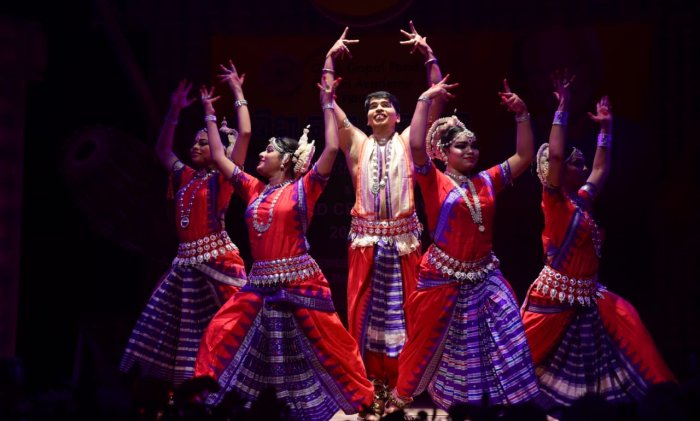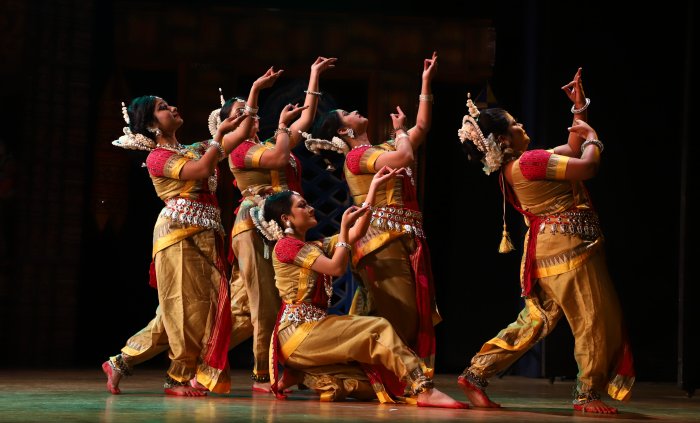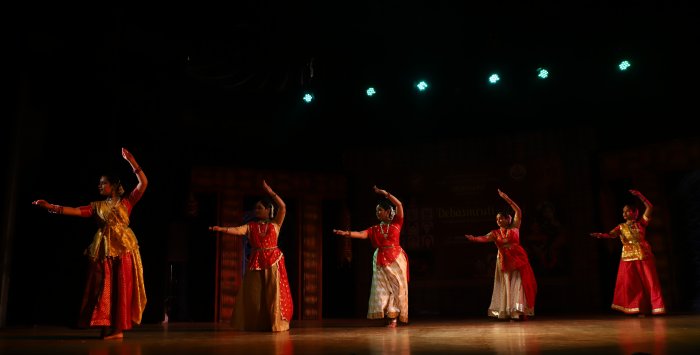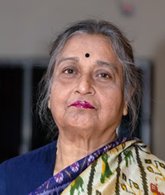
|   |

|   |
Debasmriti 2021 by Tridhara, Bhubaneswar - Dr. Nita Vidyarthi e-mail: nitavidyarthi@gmail.com Photos courtesy: Tridhara January 20, 2022 Tridhara under the guidance of its director Guru Gajendra Panda, distinguished dancer and principal custodian of the Odissi Guru Debaprasad Das' unique gharana, celebrated the 35th edition of Debasmriti on 20th December 2021 at Rabindra Mandap, Bhubaneswar.  Tridhara ensemble The evening of Odissi and Kathak dance in remembrance of the legendary Guru Debaprasad Das commenced with an uncommon item "Mahalakshmi Ashtaka" in Ragamalika and Talamalika by the senior dancers of Tridhara, choreographed and supervised by Guru Gajendra Panda. Known for his refreshingly unique composition style with the use of the 'Sabda Swara Patha', which he had mastered from his Guru and weaves in with tribal, folk and classical Odissi, Gajendra Panda brings to the fore, rural and popular village culture from the homes of Odisha, thus bringing his audience near to the land and people of this place. And this Ashtaka is a very popular one in Odisha, presented perhaps for the first time on stage. His choreography mirrors both the lasya and the vigorous tandava elements of the Sabda nritya and this Ashtaka was brilliantly embellished in stylish execution of rhythm, movement and static poses. The ninth month in the Hindu calendar is the month of Margashirsha and is considered to be auspicious for the worship of Lord Vishnu and Goddess Mahalakshmi and is dedicated to the Goddess of wealth and prosperity. On every Thursday (Mahalakshmi Guruvar) of this month, which falls between November-December (depending upon the almanac) each and every member (mostly women) worship Goddess Mahalakshmi with love, reverence and devotion (bhakti bhava) to be blessed by Mata Lakshmi with "dhana jana gopa" (wealth and prosperity). Shri Mahalakshmi Ashtaka is taken from Padma Purana and this devotional prayer was chanted by Lord Indra in praise of Mahalakshmi. This was highlighted throughout the dance composition of the production, portraying meticulously the minute details of the traditional (paramparic) Lakshmi Pooja Parampara of Odisha, starting from the decoration, rituals, ornaments of the Goddess (alankara) and her 'shuklavastra' (white attire).The performance revved up the fervour of ritualistic worship through dance. The production commenced with obeisance to the Goddess with the shloka: "Namastestu mahamaye sripeetha sura pujite Shankha chakra gada haste Mahalakshmi namostute Namaste Garudarudhe kolasura bhayankari Sarva papa hare Devi Mahalakshmi namostute." Incidents of killing Kalasura and displaying Mahalakshmi's triguna "Srishti, Sthiti, Vinashanam" were some of the sparkling points in the performance. Through movement control, abhinaya and excellent coordination, the dancers proved their training. Especially interesting was the 8th stanza "Ekakalam pathey nityam Mahapaapa vinashanam..."and the Sabda Swara Patha "Vande Mahalakshmi paada pankaja vande bhavabhaya harini...." where traditional shlokas of worship in its performance potential, blended uniformly with the choreographic style of Guru Gajendra Panda and the well-rehearsed execution of the dancers.  Bagmishree Das Bagmishree Das, granddaughter of Guru Debaprasad Das, is a regular in Debasmriti editions and was in fine fettle in her sensitive performance of her grandfather's famous composition of purshanga abhinaya set to poet Bhagirath's "Meenanayana kheena heboni" in raga Kamodi, ektali, portraying vipralambha shringara, where the Nayaka pines for his Nayika who is far away from him. A very talented dancer, her performance was set apart by the sharpness and precision that demonstrated a rare diligence. This was followed by two pleasing items composed by Gajendra Panda and directed by two of his senior disciples. 'Sthayee' by dancers of Nrutya Shridhara, Sarangarh was directed by Arya Nanda and "Uthilu ede begi kanhiki re dukhidhan" by students of Nrityadhara, Bilaspur, by Anchal Pandey.  Pushpita Mukherjee's group Guru Pushpita Mukherjee's group from Rabindra Bharati University, Kolkata, impressed with their well-rehearsed "Panchadeva Stuti" and Guru Debaprasad Das' unique composition - Kalabati Pallavi - in which those senior dancers delighted with their intricacy of steps and sense of rhythm. Sumayee Mukherjee's solo presentation 'Shiva Stuti' appealed.  Swati Agarwal and group Swati Agarwal and group from Jaipur were notable for their taiyari and neatness in both their presentations of 'Krishna Vandana' and 'Tarana' in the Kathak idiom. Their use of stage space in the Tarana had the finesse of fine and assured footwork, training and experience. They concluded with 'Vande Mataram' celebrating 'Azadi Ka Amrit Mahotsav.' Dr.Srinibas Ghatuary compered the program with his usual finesse.  Dr. Nita Vidyarthi is a veteran critic of performing arts and writes on dance, music and theatre in leading publications. |